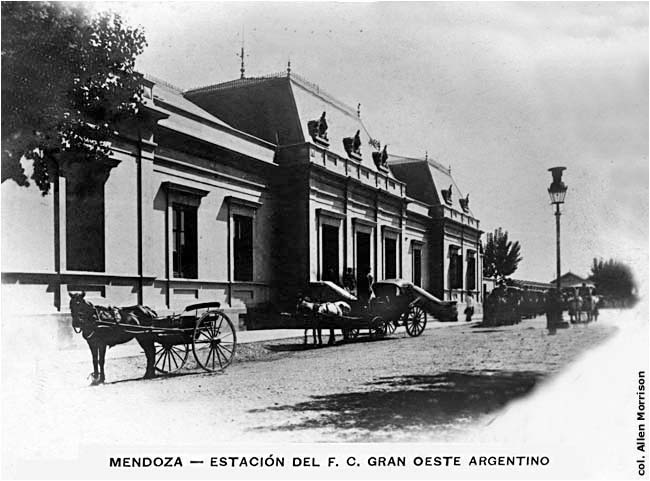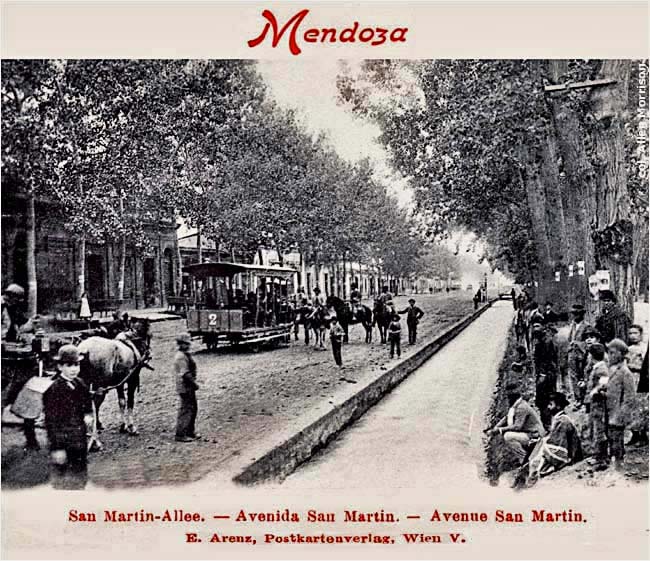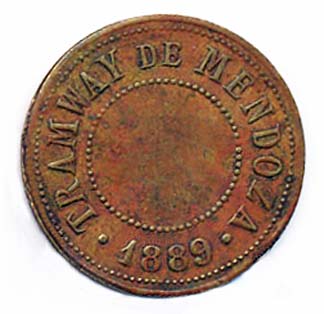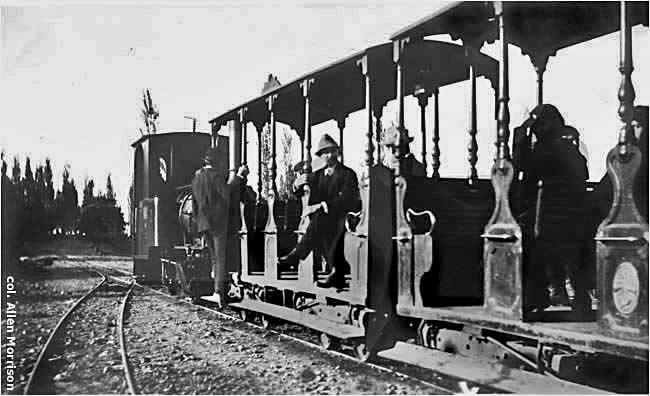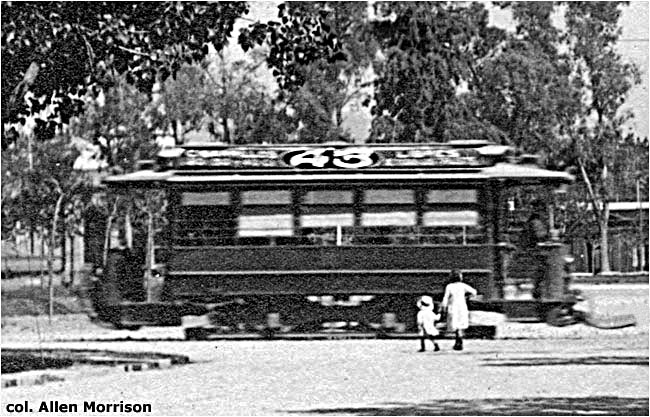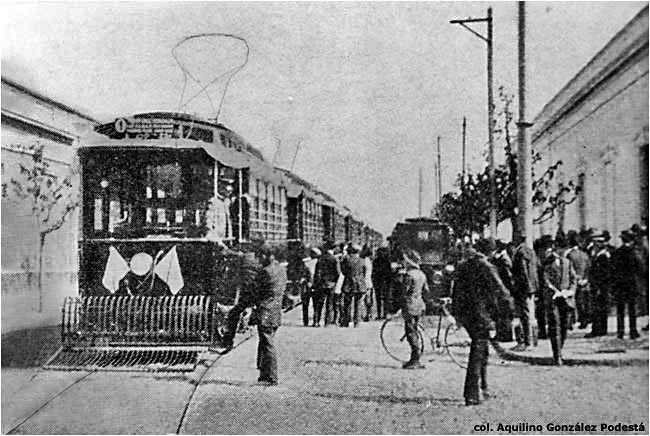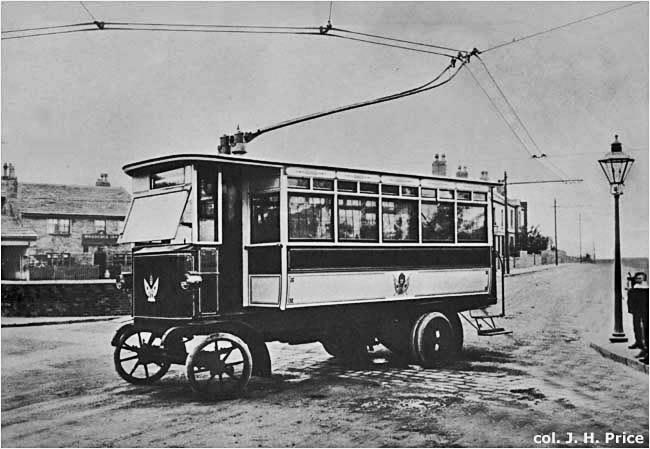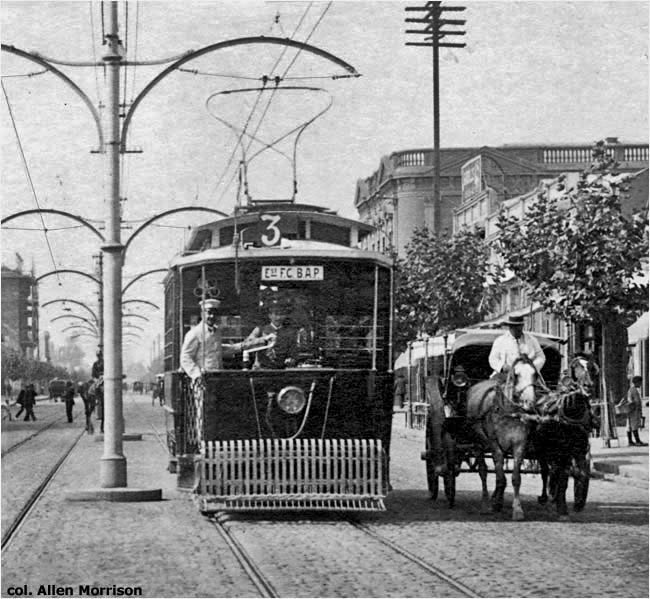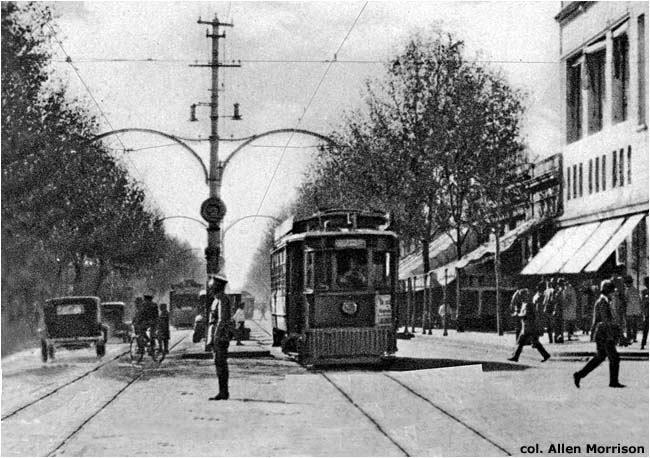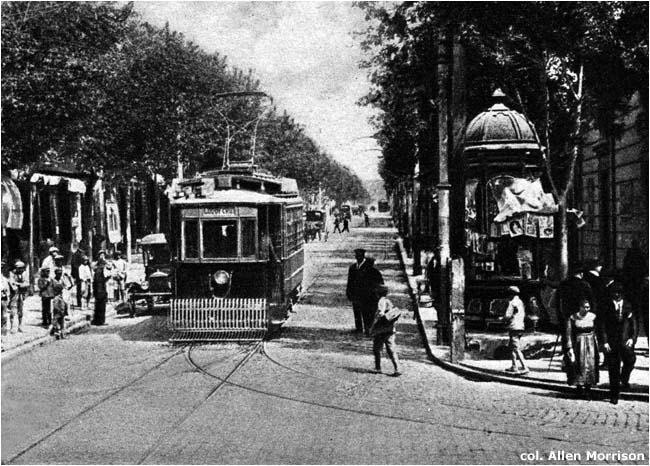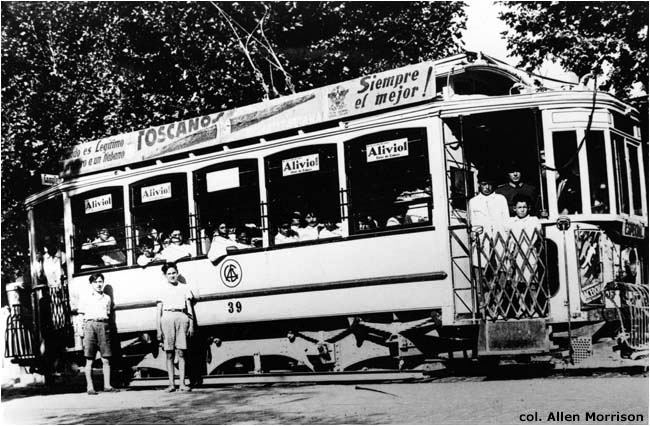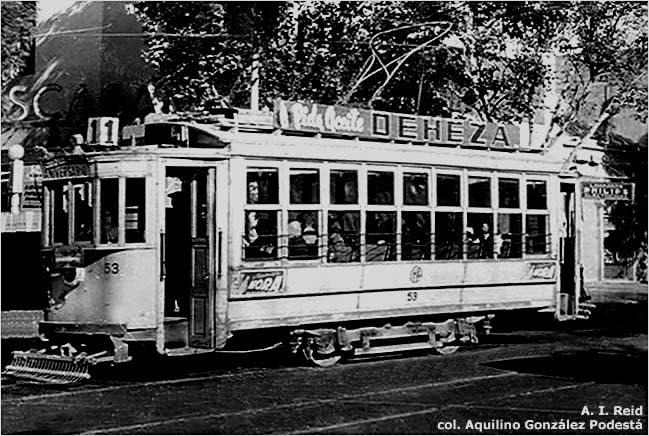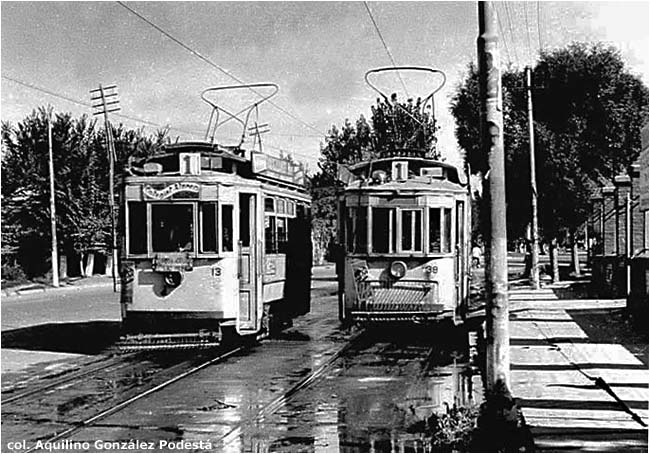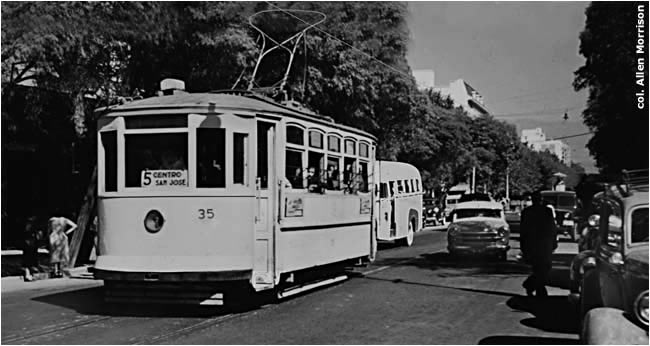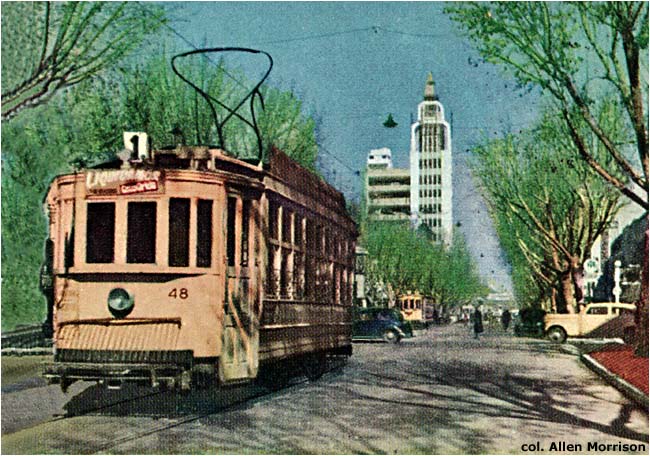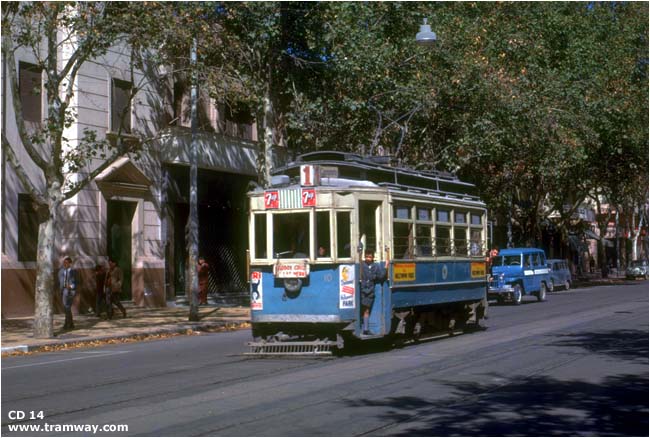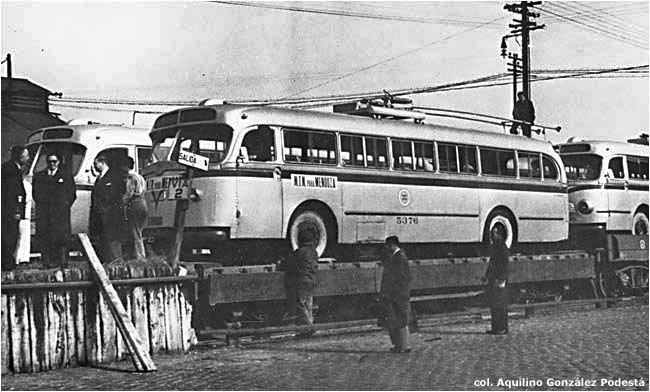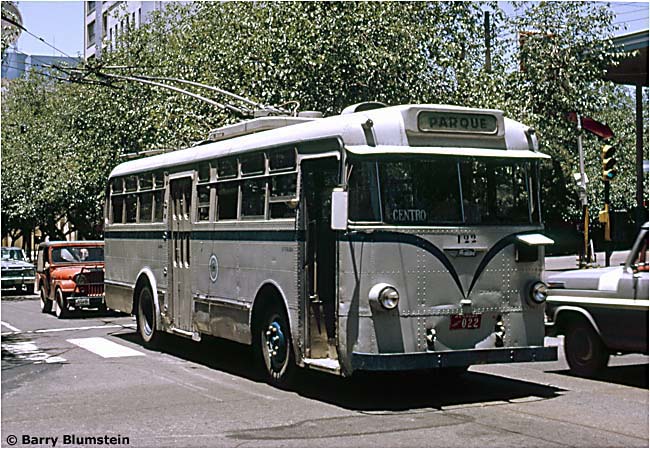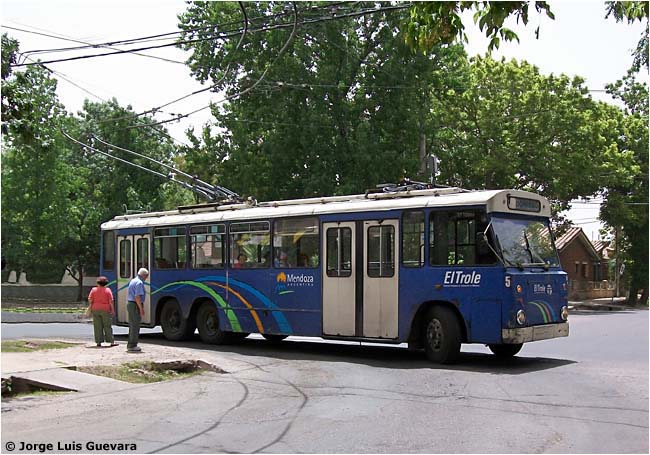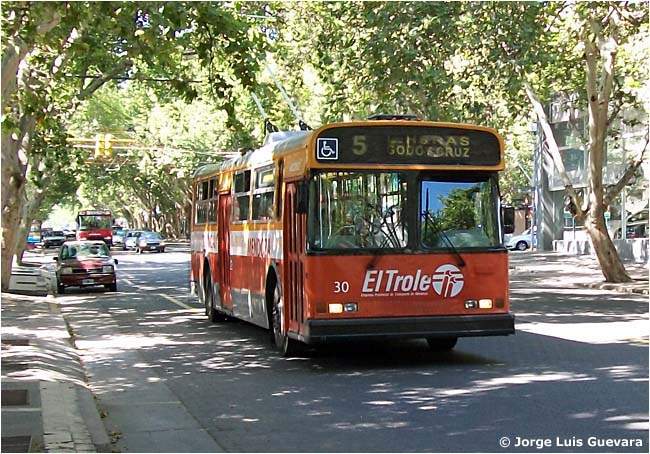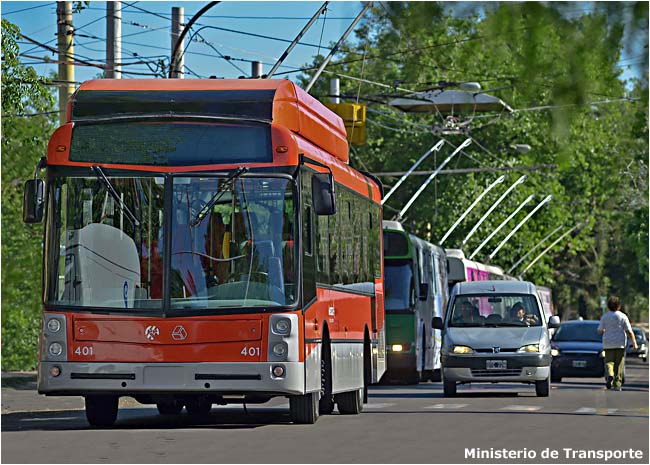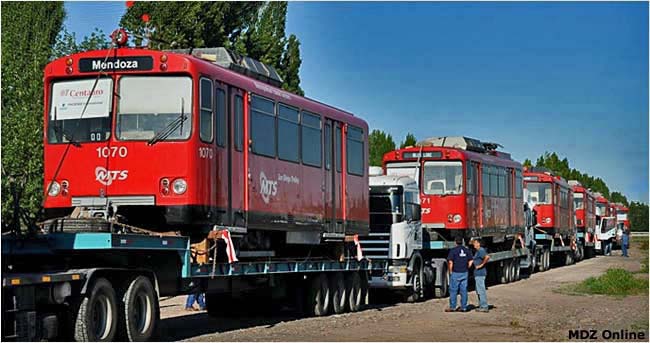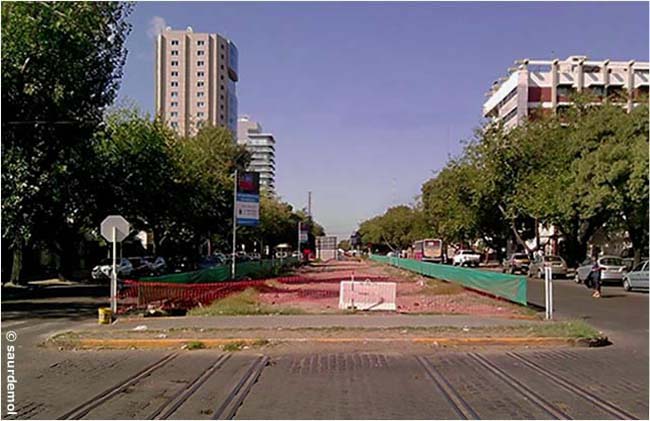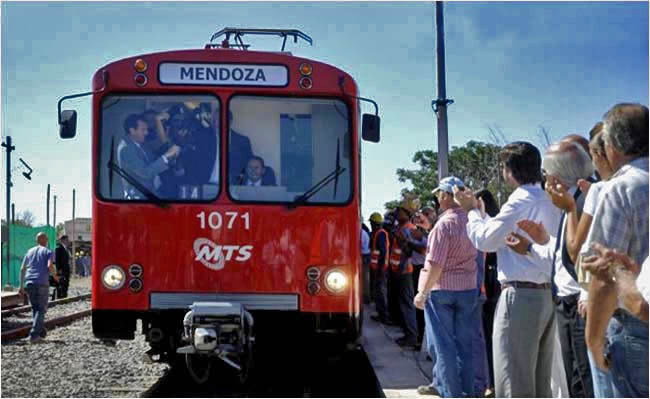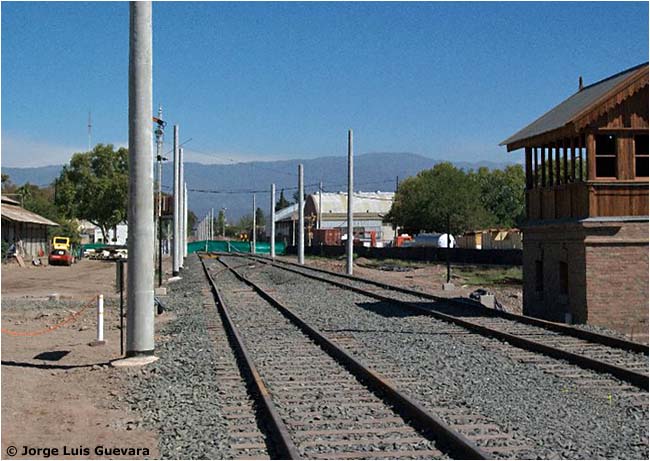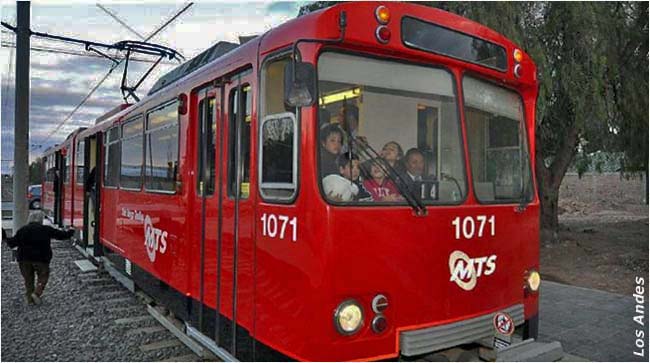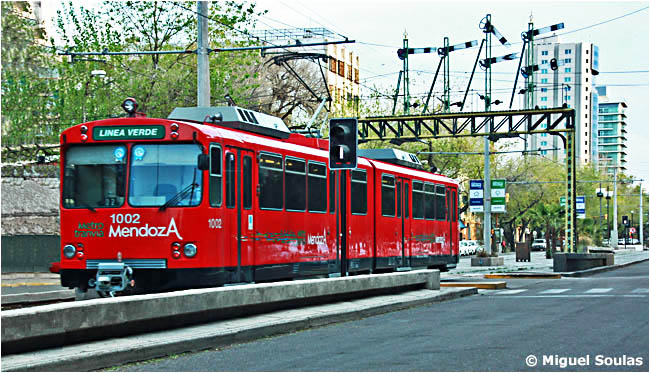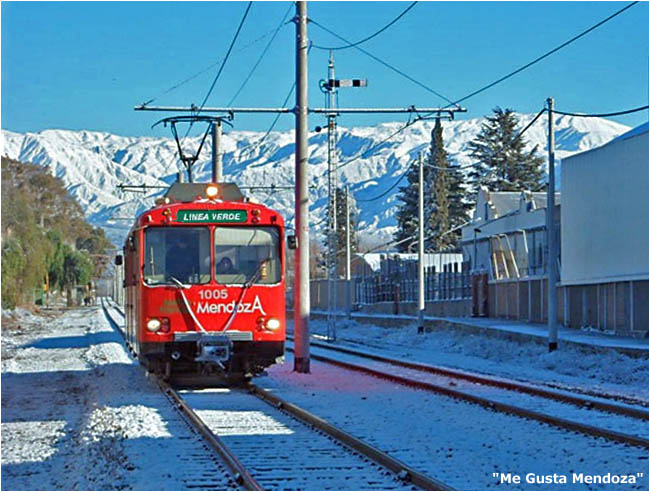MENDOZA, ARGENTINA
Trams, Trolleybuses, Metrotranvía
by
Allen Morrison
The city of Mendoza is located at the foot of the Andes in extreme western Argentina, about 1,000 km west of Buenos Aires and 200 km east of Santiago, Chile (by air; about 400 km by land). It is not far from Mount Aconcagua near the Argentine-Chilean border, which is the highest peak in both the western and southern hemispheres (altitude: 6,962 m / 22,841 ft). For many years the railroad station in Mendoza was the place where travelers changed from the narrow-gauge trains that came over the Andes from Chile to the broad-gauge trains that ran from Mendoza to other points in Argentina. The postcard reproduced below, which was mailed from Mendoza to Paris in 1906, shows the station entrance. (The station is marked "LAS HERAS" on the map. Also see the platform side of the station.) The British-owned Argentine Great Western Railway was renamed Buenos Aires & Pacific Railway in 1907 and was nationalized as Ferrocarril General San Martín in 1948 [col. AM]:
Mendoza is a pleasant, friendly city, a university town, the kick-off point for Andean excursions, and the capital of the largest wine-producing district in Latin America. Its transport development was unusually international, with vehicles and technology imported from the USA, UK, USSR, Germany, Belgium, Japan and Canada. Approximately half its trams and trolleybuses came from Germany. Population of the metropolitan area today is about 900,000. Trams
Enlargement of a tramway token. The Spanish word tranvía did not see wide use until the 20th century [col. Marcelo Cáceres Miranda]: The 1676 mm gauge steam railroad began service to Mendoza on 7 April 1885. The first section of the 1000 mm gauge Transandine Railway opened in 1891, but did not reach Los Andes, Chile, until 1910. The fourth railway to open in the Mendoza area was the 600 mm gauge Ferrocarril Liliputiense del Parque in what today is Parque General San Martín [see map]. The 7.36 km railway was built in 1906 to assist in construction of the park and the creation of a lake. Its four locomotives and trail cars, built by Orenstein & Koppel in Potsdam, Germany, transported passengers around the park from 1908 until 1923 [col. AM]: In 1910 the city's Empresa de Luz y Fuerza (Light and Power Company) was acquired by Deutsch Überseeische Elektricitäts Gesellschaft of Berlin, which was financing electric installations in Buenos Aires and other South American cities. The new owners ordered 25 two-axle electric trams from Waggonfabrik Falkenried in Hamburg, Germany, with electrical equipment by Siemens Schuckert. Here is the best side view that could be found [AM]:
Mendoza's first electric tram line – duplicating the horsecar route of 1885 – opened from the railroad station to Av. San Martín on 1 October 1912 [see map]. Track gauge remained 1435 mm [col. Aquilino González Podestá]:
Meanwhile, South American Railless Traction Co. of Great Britain, which wanted to cover the continent with electric bus lines, chose Mendoza for its first installation and built a 3 km route along Avenidas Civit and Libertador to and through Parque General San Martín [see map, 1913 report, 1915 text]. The vehicle, which was built by Milnes Voss & Co. in England and had electric motors from Siemens in Germany, inaugurated the line on 16 October 1913. It was the first trolleybus operation in South America. The company planned to extend the route another 82 km (!), but it never happened and the line allegedly ran only two years. No picture of the Mendoza operation has been found, but the photograph below shows the Mendoza vehicle testing in 1912 in Leeds (which had Britain's first trolleybus line) [col. J. H. Price]:
|
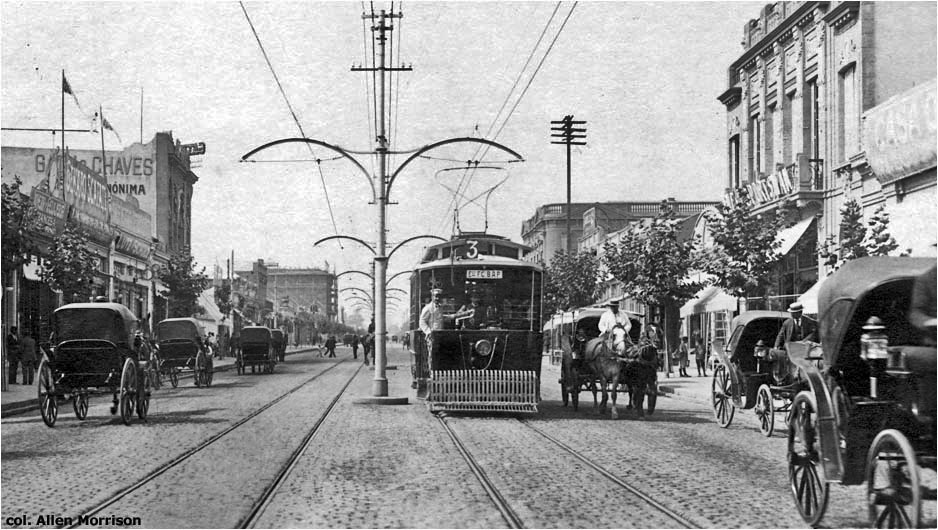
Detail of the scene above. The destination sign indicates "Est[ación] Ferro Carril Buenos Aires [al] Pacífico". Note open front platform [col. AM]:
Av. San Martín a few years later. The tram's platform has been partially enclosed [postcard, col. AM]:
Franco-Belge tram 53 in the next photograph is longer and has nine side windows, but still runs on a 2-axle truck. The Mendoza tramway never used 4-axle cars [Arnold Irvine Reid, col. Aquilino González Podestá]:
In 1930, CELA was in turn acquired by the U.S. holding company Electric Bond & Share ["EBASCO"], which controlled public utilities in 31 Latin American cities. The 1937 edition of the World Survey of Foreign Railways [see BIBLIOGRAPHY] reported 36 km of track and 78 passenger trams in Mendoza. The origin of the additional equipment is unknown, but EBASCO no doubt shifted vehicles between its systems. That was easy to do in Argentina, where most tramways used the same 1435 mm gauge. The following photograph shows a Falkenried tram from 1911 and a Ragheno tram from 1926 at the end of the line at the cemetery in Las Heras [see map] [col. Aquilino González Podestá]:
Ragheno tram 35 lost its clerestory in later years. As far as is known, it was the only vehicle with an arch roof on the Mendoza system. Compare to Ragheno tram 38 in the photograph above [col. AM]:
Traffic direction on streets throughout Argentina, including in Mendoza, changed from left to right on 10 June 1945. Adjustments were necessary on the tramway rails, but not on the vehicles, which already had doors on both sides. In this postcard view from the 1940s, Franco-Belge 48 is traveling right-hand on Av. San Martín, the city's main thoroughfare [see map]. The large 9-window cars were used exclusively on this route [col. AM]:
EBASCO was expropriated by the Perón government in 1948, and from that date forward Mendoza's trams, like those in several other Argentine cities, were operated by Agua y Energía Eléctrica ["AEE"] – the Water and Power Authority. The photograph below shows Falkenried tram 10, one of the original vehicles of 1912, now with its platform completely enclosed, still going strong in 1963 [www.tramway.com]:
Trolleybuses
The date of the picture above and other details of the Mendoza project are unclear. All its trolleybuses came from Mercedes-Benz, but reports of their quantity range from 15 to 30 vehicles. Some are believed to have operated for a while in Buenos Aires, while others came from Bahía Blanca (whose system never opened). The new Empresa Provincial de Transportes de Mendoza ["EPTM"] inaugurated the Parque line of the city's new trolleybus system – from Calle 9 de Julio over Colón and along Av. Boulogne Sur Mer – on 14 February 1958 [see map]. The tramway system continued to be run by AEE. The new trolleybus line duplicated a tram route along Av. Boulogne Sur Mer and it was soon abandoned. Other tramway services were discontinued when EPTM opened its Villa Nueva route in 1959 and Dorrego route in 1961. Av. San Martín, however, remained the exclusive province of AEE trams – and also led to its tramway depot [see map]. Trolleybuses still do not run there today (in the central area). In 1962 EPTM purchased 36 Nissan/Toshiba trolleybuses from Japan, which were the only Japanese trolleybuses that ever ran in regular service outside Japan. Number 122 was photographed by an Australian enthusiast in December 1974 [Barry Blumstein]:
AEE's tramway system closed twice. The last two lines shut in 1964, but the main route on Av. San Martín reopened later and continued operation until November 1965 [see map]. It was the second-last closure of a tramway system in Argentina. Only La Plata ran trams longer, until Christmas 1966. In 1984, in exchange for wine, EPTM acquired 17 ZiU 2-axle trolleybuses from the U.S.S.R. and in 1988 purchased 78 used Krupp/Kiepe trolleybuses (built 1968-1974) from the system in Solingen, Germany. (21 of them were acquired only for parts.) At the time, these were the only 3-axle non-articulated trolleybuses in Latin America. Number 5 was photographed on the Dorrego route in January 2010 [Jorge Luis Guevara]:
Metrotranvía
The photograph below shows the completely rebuilt and re-gauged Av. Belgrano on 17 September 2014 [see map]. Overhead signals were retained as a souvenir of the old steam railroad days [Miguel Soulas via flickr]:
This page is a work in progress. New photographs and information about the trolleybus system and the Metrotranvía will be added as these operations develop...
BIBLIOGRAPHY Mendoza, Dirección General de Industrias. "Parque del Oeste". Mendoza, 1911. An early map of Parque General San Martín at scale 1:2,000 shows the railway route. Reproduced as Fig. 295 in Jorge Ricardo Ponte's Mendoza, aquella ciudad de barro [see below]. "Deutsch-Ueberseeische Elektricitäts-Ges. in Berlin" in Handbuch der Deutschen Aktien-Gesellschaften 1914-15, Berlin, 1915. Description of its subsidiary, Empresa de Luz y Fuerza S.A. of Mendoza, p. 2226. "Electric Light, Power, and Tramway Companies" in The South American Year Book (London), 1915. Finances, operation and history of the Argentine Power & Railless Traction Co., Ltd. and the South American Railless Traction Co., Ltd., p. 161 [see here]. Frederick Magie Halsey. "Investments in Latin America & the British West Indies" in U.S. Bureau of Foreign & Domestic Commerce Special Agents Series #169. Washington, 1918. Report on the Empresa, Luz y Fuerza de Mendoza, p. 69. "Compania [sic] Hispano-Americana de Electricidad" in Le Recueil Financier 1922, Paris 1922. Details of the tramway companies acquired from the Germans in 1920. "Tranvías eléctricos de Mendoza – Recorridos" in El Amigo del Viajero (Santiago, Chile), 1922 and 1924. Itineraries of four tram routes when street traffic still ran left-hand. Municipalidad de la Capital. Plano de la Ciudad de Mendoza, 1925. Nice street map shows electric tram routes (including the Parque line which opened in 1926). "Société Financière de Transports et d'Entreprises Industrielles (SOFINA)" in The Stock Exchange Year-Book 1931, London 1931, p. 3056. Finances of the Belgian company associated with the Compañía Hispano-Americana noted above, which controlled the Mendoza tramway in the 1920s. "Tranvías de Mendoza" in Guía Peuser, Buenos Aires, 1949. Itineraries of six tram routes. Street traffic changed from left to right in 1945, so tram routes in 1949 were the reverse of those in 1922 and 1924. U.S. Bureau of Foreign & Domestic Commerce. World Survey of Foreign Railways. Supplement #31, "Argentina". Washington, 1937. Report on Compañía de Electricidad de Los Andes, p. 14. John Baird. "Mendoza" map of the tramway system. Unpublished, December 1949. Around 1950 pioneer tramway enthusiast John Baird drew detailed maps showing track layout of every tramway system in Argentina, and also of the systems in Montevideo, Uruguay, and Rio de Janeiro, Brazil (and perhaps other places unknown). Arnold Irvine Reid was an Argentine tram enthusiast, active in the late 1950s and early 1960s, who advertised and sold his pictures in U.S. magazines and distributed typewritten news reports about his visits to South American cities, including Mendoza. There is a short biography by Marcelo Cáceres Miranda on pp. 4-8 of 9 Puntos #150 (Otoño 2007) of the Asociación Amigos del Tranvía (Buenos Aires). J. H. Price. Hurst Nelson Tramcars. Hartley, U.K., nd [1977]. Illustrated history of the Scottish tram builder. On pp. 24-25 the author notes the six trolleybuses ordered in 1911 by Railless Electric Traction Co., which opened England's first trolleybus systems that year in Leeds and Bradford. Some of the vehicles were almost identical to the Mendoza trolleybus which tested in Leeds in 1912. Raymond DeGroote. Unpublished "Mendoza" map labeled "Track As Observed 4-15-63" (15 IV 1963): track layout of Las Heras - Godoy Cruz line, and turnouts along Av. San Martín. Aquilino González Podestá. "Los Sistemas Tranviarios Argentinos: Tranvías de Mendoza", pp. 4-8, in Boletín #72 (XI 1982) of the Asociación Amigos del Tranvía. The definitive history of the tramways of Mendoza. Large double-page map shows five tram routes. Steve Morgan. "Expansion in Mendoza" in Trolleybus Magazine #153 (London), May-June 1987. A 6-page survey of the Mendoza trolleybus system, with a map and five photographs taken by the author. "Mendoza adquirió 58 trolebuses usados" in La Nación (Buenos Aires), 5 IX 1988. The purchase of used trolleybuses from Solingen, Germany. "Inusual trueque de vino por trolebuses" in El Mercurio (Valparaíso, Chile), 30 I 1990. Article about the 17 Soviet ZiU trolleybuses acquired in exchange for wine in 1984. "Los nuevos recorridos de los medios de transporte" in Los Andes (Mendoza), 28 III 1991. Long article detailing a plan to eliminate all but trolleybuses from the city center. "Siete años de abandono para 41 trolebuses" in Clarín (Buenos Aires), 12 II 1996, p. 39. Newspaper article about the trolleybuses acquired from Germany in 1988, and still largely unused seven years later. Ana E. Castro. El Parque General San Martín: sus primeros cincuenta años. Mendoza, 1996. The park's early development. Construction of the railway, pp. 60-61; photo of one of its locomotives, p. 65; "El trencito" inauguration, p. 71; the electric tramway reaches the park, p. 138. No mention of the 1913 trolleybus line. "Trolebuses, una nueva opción para el transporte" in Diario Los Andes (Mendoza), date unrecorded [about 1999-2000]. An article about the city's first trolleybuses includes a section entitled "¿Troles en 1913?" which quotes the newspaper's description of the pioneer line. Alan Murray. World Trolleybus Encyclopaedia. Reading, U.K., 2000. The "Railless" entry on p. 120 of the list of U.K. manufacturers notes a 2-axle demonstrator supplied to Argentina in 1909-23. Aníbal F. Trasmonte. El Trolebús, y Otros Ómnibus Eléctricos. Buenos Aires, 2001. The chapter on Mendoza, pp. 76-86, summarizes trolleybus development and contains 12 illustrations. Empresa Provincial de Transportes de Mendoza. "Líneas de Trolebuses" colored route map. Undated, but published about 2007. Jorge Ricardo Ponte. Mendoza, aquella ciudad de barro: historia de una ciudad andina desde el siglo XVI hasta nuestros días. Buenos Aires: 2nd edition, 2008. Impressive 651-page album with 687 illustrations and 140 maps. Fig. 295 is a 1911 map of Parque del Oeste (today Parque General San Martín) which shows the railway line. Fig. 308 is a large tram view of Av. San Martín. Fig 327 is a 1925 street map showing the tram routes. Unfortunately, no mention could be found anywhere of the 1913 trolleybus line. Steve Morgan. "Mendoza Update" in Trolleybus Magazine #291 (London), V-VI 2010, pp. 51-54. News report, three color photographs and two maps: of the entire system and of the central area. Fernando Vallina Padró. "Los Trolebuses de Mendoza" in 9 Puntos #147-150 of the Asociación Amigos del Tranvía. Buenos Aires, 2006-2007. A 4-part illustrated survey of trolleybus development. Parts 1 and 2 are available as downloadable PDFs. Jorge Luis Guevara. Trolebuses Mendocinos. Elaborate blog site, with data, news, photographs and videos about the trolleybuses of Mendoza and other systems in Argentina. Constantly updated. Recommended. Jorge Luis Guevara. Metrotranvía de Mendoza. Facebook page with numerous photographs. May require registration to view. Gobierno de Mendoza. Ministerio de Infraestructura, Vivienda y Transporte. Etapas del Metrotranvía. Map shows future light rail extensions. Gobierno de Mendoza. Ministerio de Infraestructura, Vivienda y Transporte. Metrotranvía de Mendoza. 4 1/2 minute video simulates a ride on the line. The author is especially indebted to Jorge Luis Guevara of Mendoza, Aquilino González Podestá and Marcelo Cáceres Miranda of Buenos Aires, Alan Murray of London, and the late J. H. Price of Cambridge, England, for the information and images that they supplied for this page.
–––––––––––––––––––––––––––
See Also see my index of If you have comments, criticism or suggestions, This first version of this page Copyright © 2011-2111 Allen Morrison |
